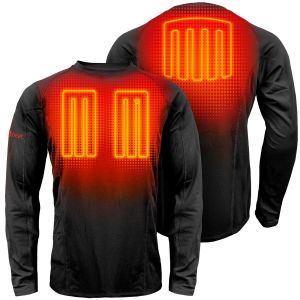Heated clothing technology has come a long way in recent years, with advancements in materials and battery technology making it possible for individuals to stay warm and comfortable even in the coldest of environments.
In this blog post, we will explore the science behind heated clothing technology, including the materials used and the science behind how they work.
Materials Used in Heated Clothing Technology
The materials used in heated clothing technology vary, but the most common include carbon fibers, copper fibers, and conductive materials. These materials are woven into the fabric of the clothing and are responsible for conducting electricity, which creates heat.
Carbon fibers are a popular choice for heated clothing because they are strong, lightweight, and have a high conductivity. They are often used in gloves and socks, where flexibility is important.
Copper fibers are another popular choice for heated clothing. They are highly conductive and can be easily woven into fabrics, making them ideal for jackets, vests, and other larger pieces of clothing.
Conductive materials are also used in heated clothing, such as graphene and silver. These materials have a high conductivity and can be used in a variety of clothing items.
The Science Behind Heated Clothing Technology
Heated clothing technology works by using a battery-powered heating element that is integrated into the fabric of the clothing. When the battery is turned on, it supplies power to the heating element, which generates heat.
The heat is conducted through the materials in the clothing and is distributed evenly throughout the garment. This means that the wearer can experience warmth and comfort even in the coldest of environments.
The battery life of heated clothing varies depending on the type of clothing and the size of the battery. Some batteries can last up to 10 hours, while others may only last a few hours. It’s important to choose a battery that is appropriate for your needs and to follow the manufacturer’s instructions for charging and maintaining the battery.
Benefits of Heated Clothing Technology
The benefits of heated clothing technology are numerous. Firstly, it can provide warmth and comfort in cold environments, making it ideal for individuals who work or spend time outdoors in the winter. It can also be used for individuals who have poor circulation or medical conditions that make them more sensitive to cold temperatures.
Heated clothing technology is also lightweight and flexible, making it easy to wear and move around in. It can be worn under other clothing without adding bulk or discomfort.
In conclusion, the science behind heated clothing technology is relatively simple. By using conductive materials woven into the fabric of the clothing, and a battery-powered heating element, heated clothing can provide warmth and comfort in cold environments.
The benefits of heated clothing technology are numerous, making it a popular choice for individuals who work or spend time outdoors in the winter, or for those who have medical conditions that make them more sensitive to cold temperatures.
By choosing high-quality heated clothing from a reputable manufacturer and following best practices for use and maintenance, you can enjoy the benefits of heated clothing technology with confidence and comfort.

For over 12 years, I have been testing and reviewing heating technologies that overcome cold weather conditions. In recent years, I have specialized in the heated apparel. I’ve made it my mission to educate people about heated clothing.
